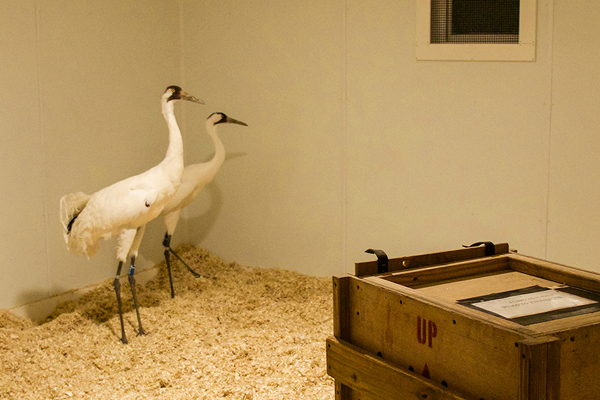
Media Contact: Pamela Seelman, 608-356-9462 ext. 120
BARABOO, WI – Three pairs of breeding Whooping Cranes recently moved to Crane City at the International Crane Foundation, relocating from the Patuxent Wildlife Research Center in Maryland.
In 2017 the U.S. Geological Survey announced the closure of the Whooping Crane breeding program at Patuxent, creating the need to relocate 75 Whooping Cranes. (learn more about the closure).
“The International Crane Foundation received the three Whooping Crane breeding pairs March 14,” said Kim Boardman, curator of birds at the International Crane Foundation. “The new birds will join 38 Whooping Cranes housed at our headquarters.” The International Crane Foundation is only one of several Whooping Crane breeding centers in North America.
With Patuxent’s closing, new homes are being identified for the 75 Whooping Cranes formerly residing there. “Many safeguards are in place to ensure that the Whooping Cranes housed at Patuxent find new homes, to continue to be managed and benefit the species,” Boardman explained.
Although the six new members of Crane City are settling in, it might take one or two years for them to begin breeding again. “In the meantime, we at the International Crane Foundation will continue our leadership role in rearing cranes for release in Louisiana and Wisconsin this fall,” said Boardman.
Our staff, Senior Aviculturist Kyle Tainter and GIS Intern Brian Barbieri, met the Patuxent staff
half-way between our two organizations to do the transfer – a long drive, but well work the effort!
The International Crane Foundation is a member of the Whooping Crane Eastern Partnership (WCEP), which is working to create a self-sustaining flock of Whooping Cranes in the Eastern Flyway. In 2017, WCEP released 18 Whooping Cranes into the wild, with16 surviving. In 2016, WCEP released 12 Whooping Cranes, of which eight still survive.
Other facilities receiving birds from Patuxent as breeding partners include White Oak Conservation Center in Florida, Dallas Zoo and San Antonio Zoo in Texas, Smithsonian Conservation Biology Institute in Virginia, the Freeport-McMoRan Audubon Species Survival Center in Louisiana, and the Calgary Zoo, Alberta Canada.
The Whooping Crane International Recovery team worked collaboratively with the Association of Zoos and Aquariums Whooping Crane Species Survival Plan to identify appropriate facilities to take the available birds. All facilities must pass approved criteria to receive birds and be committed to the future of the species.
“We are excited to strengthen our partnerships with these facilities as they grow their expertise in Whooping Crane breeding and management, added Boardman. “Non-breeding birds will be placed throughout other institutions for exhibit purposes.”
###
